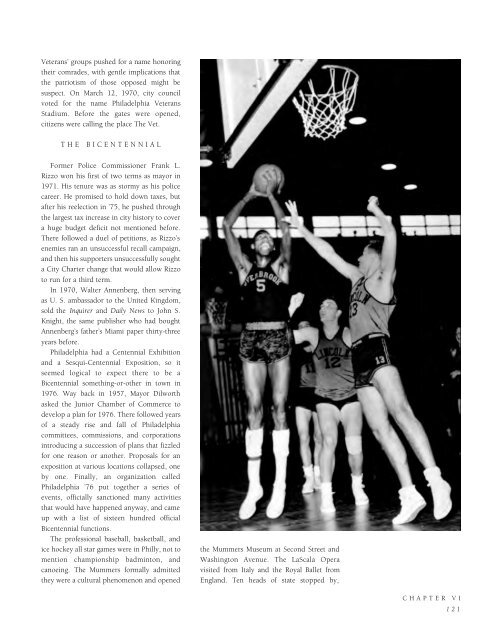Historic Philadelphia
An illustrated history of the city of Philadelphia, paired with the histories of companies, families and organizations that make the region great.
An illustrated history of the city of Philadelphia, paired with the histories of companies, families and organizations that make the region great.
Create successful ePaper yourself
Turn your PDF publications into a flip-book with our unique Google optimized e-Paper software.
Veterans’ groups pushed for a name honoring<br />
their comrades, with gentle implications that<br />
the patriotism of those opposed might be<br />
suspect. On March 12, 1970, city council<br />
voted for the name <strong>Philadelphia</strong> Veterans<br />
Stadium. Before the gates were opened,<br />
citizens were calling the place The Vet.<br />
THE<br />
BICENTENNIAL<br />
Former Police Commissioner Frank L.<br />
Rizzo won his first of two terms as mayor in<br />
1971. His tenure was as stormy as his police<br />
career. He promised to hold down taxes, but<br />
after his reelection in ’75, he pushed through<br />
the largest tax increase in city history to cover<br />
a huge budget deficit not mentioned before.<br />
There followed a duel of petitions, as Rizzo’s<br />
enemies ran an unsuccessful recall campaign,<br />
and then his supporters unsuccessfully sought<br />
a City Charter change that would allow Rizzo<br />
to run for a third term.<br />
In 1970, Walter Annenberg, then serving<br />
as U. S. ambassador to the United Kingdom,<br />
sold the Inquirer and Daily News to John S.<br />
Knight, the same publisher who had bought<br />
Annenberg’s father’s Miami paper thirty-three<br />
years before.<br />
<strong>Philadelphia</strong> had a Centennial Exhibition<br />
and a Sesqui-Centennial Exposition, so it<br />
seemed logical to expect there to be a<br />
Bicentennial something-or-other in town in<br />
1976. Way back in 1957, Mayor Dilworth<br />
asked the Junior Chamber of Commerce to<br />
develop a plan for 1976. There followed years<br />
of a steady rise and fall of <strong>Philadelphia</strong><br />
committees, commissions, and corporations<br />
introducing a succession of plans that fizzled<br />
for one reason or another. Proposals for an<br />
exposition at various locations collapsed, one<br />
by one. Finally, an organization called<br />
<strong>Philadelphia</strong> ’76 put together a series of<br />
events, officially sanctioned many activities<br />
that would have happened anyway, and came<br />
up with a list of sixteen hundred official<br />
Bicentennial functions.<br />
The professional baseball, basketball, and<br />
ice hockey all star games were in Philly, not to<br />
mention championship badminton, and<br />
canoeing. The Mummers formally admitted<br />
they were a cultural phenomenon and opened<br />
the Mummers Museum at Second Street and<br />
Washington Avenue. The LaScala Opera<br />
visited from Italy and the Royal Ballet from<br />
England. Ten heads of state stopped by,<br />
CHAPTER VI<br />
121
















